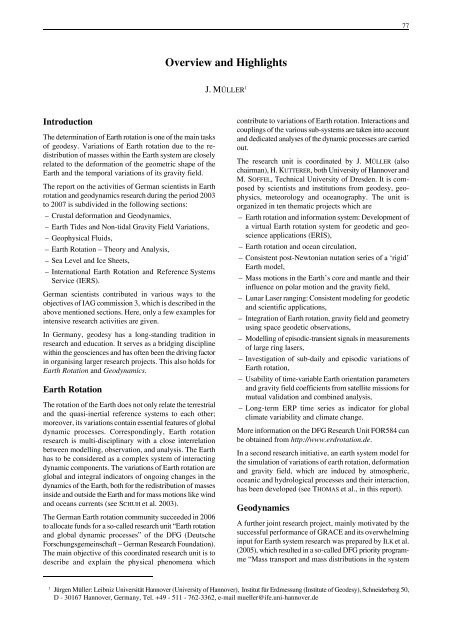NATIONAL REPORT OF THE FEDERAL REPUBLIC OF ... - IAG Office
NATIONAL REPORT OF THE FEDERAL REPUBLIC OF ... - IAG Office
NATIONAL REPORT OF THE FEDERAL REPUBLIC OF ... - IAG Office
You also want an ePaper? Increase the reach of your titles
YUMPU automatically turns print PDFs into web optimized ePapers that Google loves.
Introduction<br />
The determination of Earth rotation is one of the main tasks<br />
of geodesy. Variations of Earth rotation due to the redistribution<br />
of masses within the Earth system are closely<br />
related to the deformation of the geometric shape of the<br />
Earth and the temporal variations of its gravity field.<br />
The report on the activities of German scientists in Earth<br />
rotation and geodynamics research during the period 2003<br />
to 2007 is subdivided in the following sections:<br />
– Crustal deformation and Geodynamics,<br />
– Earth Tides and Non-tidal Gravity Field Variations,<br />
– Geophysical Fluids,<br />
– Earth Rotation – Theory and Analysis,<br />
– Sea Level and Ice Sheets,<br />
– International Earth Rotation and Reference Systems<br />
Service (IERS).<br />
German scientists contributed in various ways to the<br />
objectives of <strong>IAG</strong> commission 3, which is described in the<br />
above mentioned sections. Here, only a few examples for<br />
intensive research activities are given.<br />
In Germany, geodesy has a long-standing tradition in<br />
research and education. It serves as a bridging discipline<br />
within the geosciences and has often been the driving factor<br />
in organising larger research projects. This also holds for<br />
Earth Rotation and Geodynamics.<br />
Earth Rotation<br />
The rotation of the Earth does not only relate the terrestrial<br />
and the quasi-inertial reference systems to each other;<br />
moreover, its variations contain essential features of global<br />
dynamic processes. Correspondingly, Earth rotation<br />
research is multi-disciplinary with a close interrelation<br />
between modelling, observation, and analysis. The Earth<br />
has to be considered as a complex system of interacting<br />
dynamic components. The variations of Earth rotation are<br />
global and integral indicators of ongoing changes in the<br />
dynamics of the Earth, both for the redistribution of masses<br />
inside and outside the Earth and for mass motions like wind<br />
and oceans currents (see SCHUH et al. 2003).<br />
The German Earth rotation community succeeded in 2006<br />
to allocate funds for a so-called research unit “Earth rotation<br />
and global dynamic processes” of the DFG (Deutsche<br />
Forschungsgemeinschaft – German Research Foundation).<br />
The main objective of this coordinated research unit is to<br />
describe and explain the physical phenomena which<br />
Overview and Highlights<br />
J. MÜLLER 1<br />
1 Jürgen Müller: Leibniz Universität Hannover (University of Hannover), Institut für Erdmessung (Institute of Geodesy), Schneiderberg 50,<br />
D - 30167 Hannover, Germany, Tel. +49 - 511 - 762-3362, e-mail mueller@ife.uni-hannover.de<br />
77<br />
contribute to variations of Earth rotation. Interactions and<br />
couplings of the various sub-systems are taken into account<br />
and dedicated analyses of the dynamic processes are carried<br />
out.<br />
The research unit is coordinated by J. MÜLLER (also<br />
chairman), H. KUTTERER, both University of Hannover and<br />
M. S<strong>OF</strong>FEL, Technical University of Dresden. It is composed<br />
by scientists and institutions from geodesy, geophysics,<br />
meteorology and oceanography. The unit is<br />
organized in ten thematic projects which are<br />
– Earth rotation and information system: Development of<br />
a virtual Earth rotation system for geodetic and geoscience<br />
applications (ERIS),<br />
– Earth rotation and ocean circulation,<br />
– Consistent post-Newtonian nutation series of a ‘rigid’<br />
Earth model,<br />
– Mass motions in the Earth’s core and mantle and their<br />
influence on polar motion and the gravity field,<br />
– Lunar Laser ranging: Consistent modeling for geodetic<br />
and scientific applications,<br />
– Integration of Earth rotation, gravity field and geometry<br />
using space geodetic observations,<br />
– Modelling of episodic-transient signals in measurements<br />
of large ring lasers,<br />
– Investigation of sub-daily and episodic variations of<br />
Earth rotation,<br />
– Usability of time-variable Earth orientation parameters<br />
and gravity field coefficients from satellite missions for<br />
mutual validation and combined analysis,<br />
– Long-term ERP time series as indicator for global<br />
climate variability and climate change.<br />
More information on the DFG Research Unit FOR584 can<br />
be obtained from http://www.erdrotation.de.<br />
In a second research initiative, an earth system model for<br />
the simulation of variations of earth rotation, deformation<br />
and gravity field, which are induced by atmospheric,<br />
oceanic and hydrological processes and their interaction,<br />
has been developed (see THOMAS et al., in this report).<br />
Geodynamics<br />
A further joint research project, mainly motivated by the<br />
successful performance of GRACE and its overwhelming<br />
input for Earth system research was prepared by ILK et al.<br />
(2005), which resulted in a so-called DFG priority programme<br />
“Mass transport and mass distributions in the system











